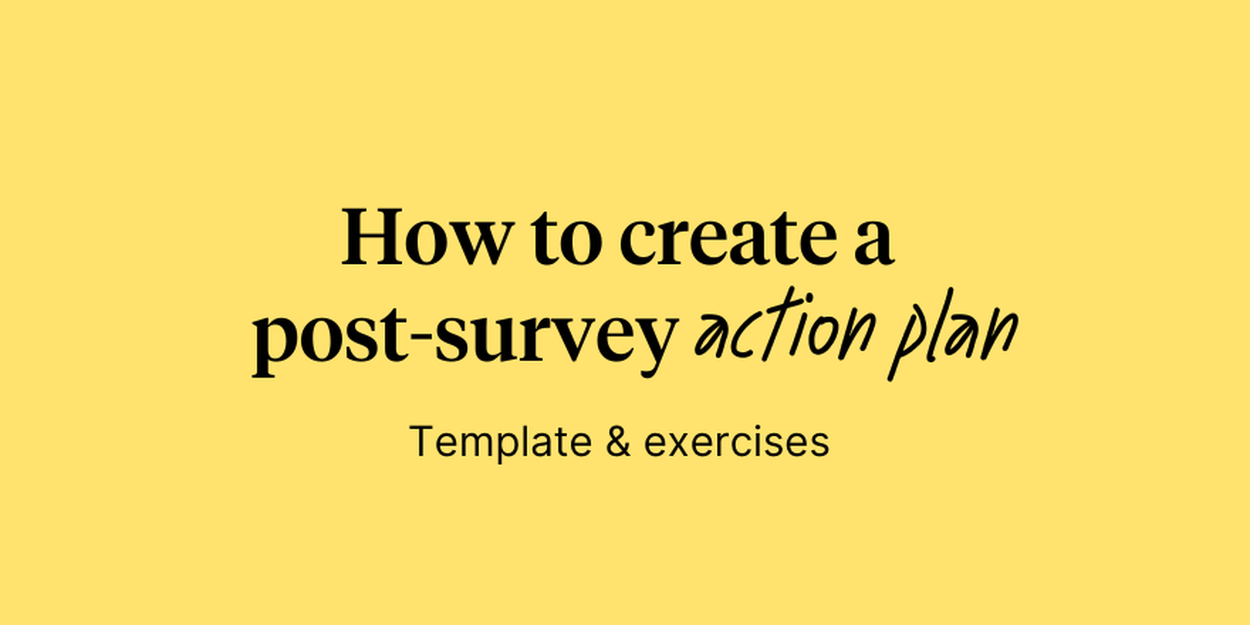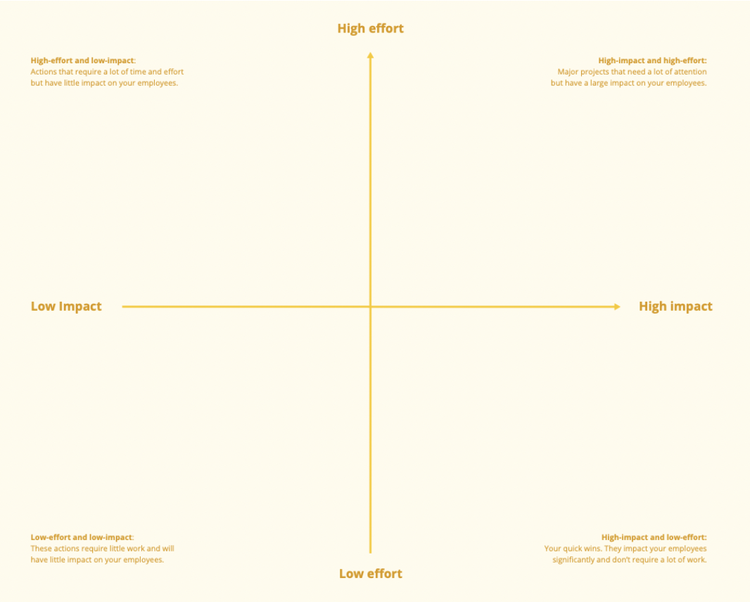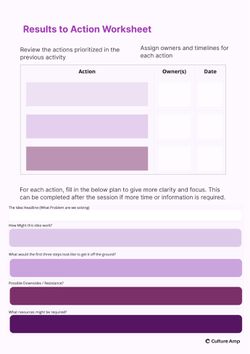
How to create a post-survey action plan (template and exercises)

People typically think of employee engagement surveys as opportunities to collect employee data – but that’s only the first step of the process. The next, and arguably most important, part is analyzing your survey results and working with internal stakeholders and leaders to identify where to take effective action.
To simplify the process of moving from understanding results to taking action, Culture Amp’s people scientists have partnered with digital collaboration platform Miro. Using our Results to Action Template, your team can determine where to direct your time and resources for the greatest impact on your people and business.
Grab the template and follow these seven steps to analyze your survey results, create meaningful action plans, and drive impactful organizational change:
1. Schedule a meeting
First things first: Start by dedicating time for your results-to-action discussion. Choose a time that works for your key stakeholders and send out an agenda beforehand so everyone comes prepared with the necessary context to make the most of the meeting. In your calendar invite, clearly state the objective of the meeting (i.e., identifying 1-3 actionable steps to improve life at your company) and set expectations for participation (come prepared to ask questions, share feedback, and brainstorm). Because this is an interactive meeting, we urge you to set aside one to two hours to get the most out of it without feeling rushed.
Have you heard of the IKEA effect? Essentially, people are more likely to like something they’ve helped create. Using our Miro template is an excellent way to involve your team in the action planning and execution process. A collaborative approach to the ideation process creates a sense of ownership, enables creativity, develops trust, and builds upon the momentum you've gained in sharing your results.
2. Briefly review results
Before you dive into your discussion, take a few minutes at the start of the meeting to review your latest engagement survey results. This will give everyone the context they need to have a meaningful and pointed discussion.
While narrowing your focus can be challenging, Culture Amp’s employee experience platform comes with an intelligent Focus Agent that identifies your company’s largest areas of improvement. Taking the time to manually analyze results and pull actionable insights can be time-consuming, so Focus Agent sifts through the data for you, highlighting areas where action will most likely have the greatest impact on employee engagement (or your outcome of focus).
Looking to identify focus areas yourself? Look for areas that:
- Have a strong impact on engagement, such as lower favorable scores and larger negative gaps to available internal and external comparisons.
- Your business is willing to put resources behind (money, effort, time, people)
- Your team and employees feel optimistic about addressing
- Align with your organization’s needs, goals, and objectives.
3. Identify what’s working and what’s not
This stage is where using an interactive tool like Miro can really shine. Ask meeting attendees to answer these two questions:
- What are we doing well?
- What are we doing not so well?
Use sticky notes in Miro to list the top three responses to each question. These answers will direct the next steps of your discussion. Of course, you can always use physical sticky notes or a whiteboard for in-person discussions, or another technology to involve virtual participants.
4. Take time to “brainwrite” improvements
Now that you’ve identified your top areas of opportunity, it’s time to kick off your brainstorm – but rather than encouraging attendees to voice ideas aloud, consider what organizational psychologist and bestselling author Adam Grant calls “brainwriting.” According to Grant, brainstorming, or ideating together as a group, can actually discourage diversity of thought. Instead, he recommends brainwriting, or having participants take a few minutes to write down their thoughts individually then coming together as a group to share and vote on the ideas.
When you kick off this portion of your meeting, give every participant roughly five minutes to write down as many ideas as possible. Encourage attendees not to focus on perfection but to jot down whatever comes to mind on different colored sticky notes using Miro or even just an old-fashioned piece of paper.
Next up is the big reveal! When time is up, have everyone add their ideas to your interactive Miro board. Organize them by grouping similar ideas. Then, review all the suggestions as a team and pick your favorites. Of course, feel free to add and vote on any new ideas that pop up during your discussion.
5. Use an effort vs. impact matrix
While this step is optional, it can be particularly helpful if no clear winners emerge from your brainwrite. Create an effort vs. impact matrix, and move each suggestion to one of four quadrants:
- Low impact and high effort: Actions that require a lot of time and effort but have little effect on your employees.
- Low impact and low effort: Actions that require little work and will have little effect on your employees.
- High impact and high effort: Actions that need a lot of attention and resources but will have a large impact on employees.
- High impact and low effort: Actions that are quick wins, meaning they will have a significant impact on your workforce while requiring little to no work.

An example of an effort vs. impact matrix that can help your team identify high-impact, low-effort initiatives
By moving each idea into a quadrant, you can quickly develop a better understanding of which suggestions are more resource- and time-intensive and which have the highest potential to create lasting workplace improvements. This can help you select the best ideas for your business and employees.
6. Plan next steps
Once you have one to three clear action plans in place, you’re ready to move these efforts forward. To ensure they live on beyond this meeting, you’ll need to:
- Document your action items
- Set completion deadlines
- Assign owners to drive accountability
If you have time left in your meeting, you can flesh these ideas out further. This may include identifying any additional steps you’ll need to take, addressing limitations, assessing resource requirements, and more. This process can provide you and your team with clear next steps to ensure you can get right to work on these initiatives.
7. Add your action plan to Culture Amp
Once you’ve agreed on what actions your organization will take, add them to Culture Amp and create an action plan. Action plans act as a public commitment, holding your organization accountable for achieving these actions. They also make progress easy to track.
Ready to create your own action plan? Check out our Take Action with the Action Framework support page.
Take action with Culture Amp and Miro
Utilizing our Results to Action Template, your business can pinpoint areas for improvement, brainstorm effective strategies, and construct an action plan to drive positive change. Culture Amp is here to help your business swiftly and efficiently identify focus areas and high-impact programs, while Miro facilitates collaborative brainstorming sessions to generate impactful ideas that drive meaningful workplace improvements.
Are you prepared to invest in your organization and its people? Download Culture Amp and Miro’s Results to Action template and follow our step-by-step guide to prioritizing high-impact actions from employee surveys.

Not using Culture Amp and Miro yet?
Download our Results to action worksheet to help you turn your survey insights into a meaningful path forward.


